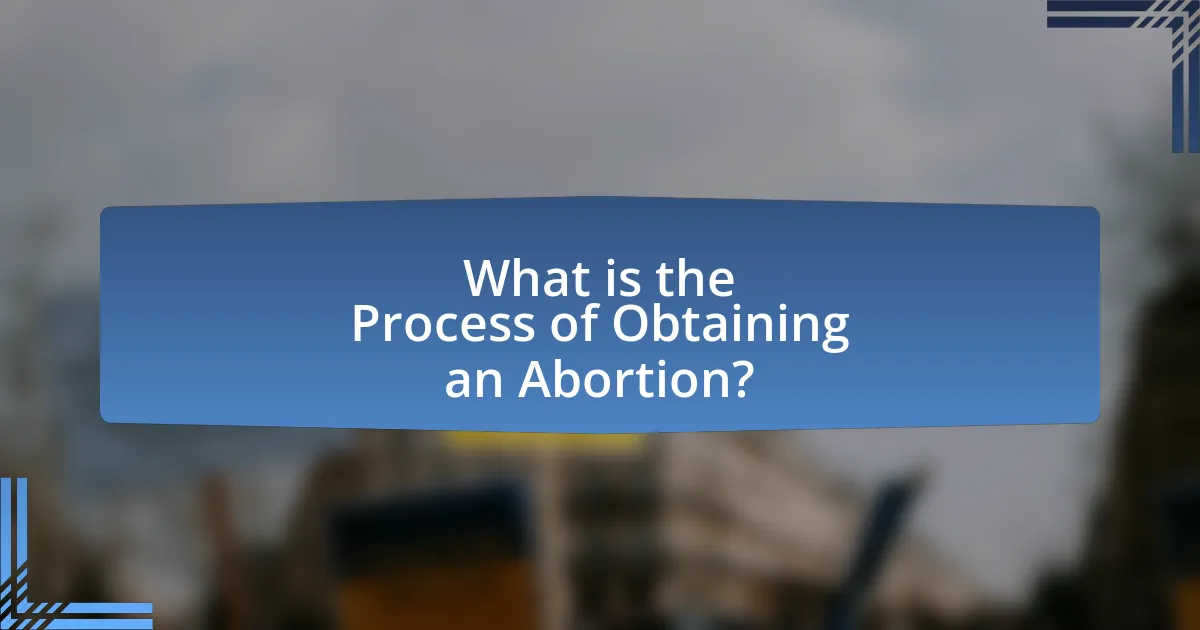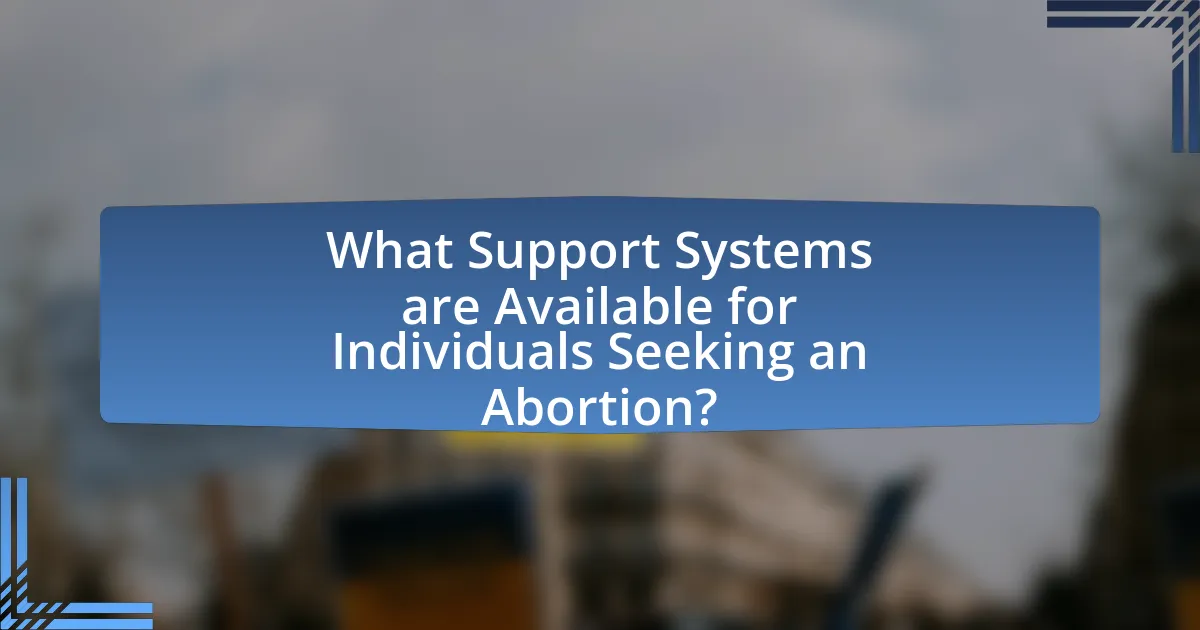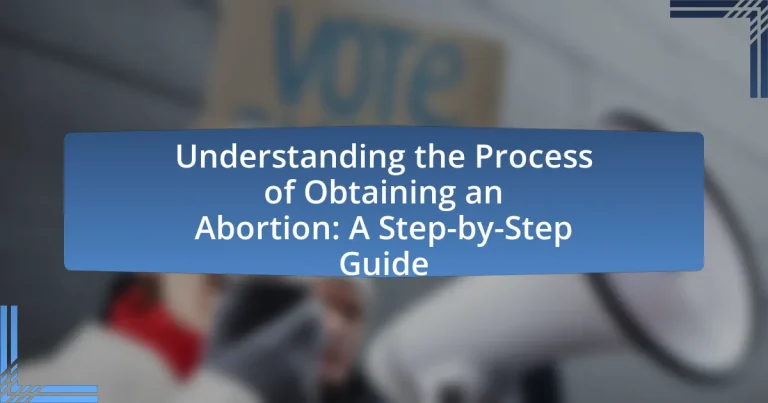The article provides a comprehensive overview of the process of obtaining an abortion, detailing the necessary steps, types of procedures, and legal considerations involved. It defines abortion in medical terms and explores the various methods available, including medication and surgical options. The article also addresses the reasons individuals seek abortions, the emotional and physical impacts, and the support systems available for those considering the procedure. Additionally, it examines the legal and ethical debates surrounding abortion, highlighting the significant variations in laws and cultural beliefs that influence access and societal views on the topic.

What is the Process of Obtaining an Abortion?
The process of obtaining an abortion typically involves several key steps. First, an individual must consult with a healthcare provider to discuss options, which may include medication or a surgical procedure, depending on the gestational age and personal circumstances. Following this consultation, the individual may undergo necessary medical evaluations, such as ultrasounds or blood tests, to confirm the pregnancy and assess health conditions.
If medication is chosen, the process usually involves taking two different pills: the first to block the hormone progesterone and the second to induce contractions. If a surgical option is selected, procedures like aspiration or dilation and curettage may be performed in a clinical setting.
Legal regulations vary by location, impacting the availability and requirements for obtaining an abortion, such as waiting periods or parental consent for minors. According to the Guttmacher Institute, as of 2021, 93% of U.S. counties do not have an abortion provider, highlighting the importance of understanding local access and laws.
How is an abortion defined in medical terms?
An abortion is defined in medical terms as the termination of a pregnancy by the removal or expulsion of an embryo or fetus from the uterus before it can survive independently outside the womb. This medical procedure can occur spontaneously, known as a miscarriage, or be induced through various methods, including medication or surgical intervention. The World Health Organization recognizes abortion as a common medical procedure, with millions performed annually worldwide, highlighting its significance in reproductive health.
What are the different types of abortion procedures?
There are several types of abortion procedures, including medication abortion, aspiration (suction) abortion, dilation and curettage (D&C), and dilation and evacuation (D&E). Medication abortion involves taking pills to terminate a pregnancy, typically within the first 10 weeks. Aspiration abortion uses suction to remove the contents of the uterus and is usually performed in the first trimester. D&C involves scraping the uterine lining and is often used for miscarriages but can also be used for abortions. D&E is a surgical procedure used in the second trimester that involves dilating the cervix and removing the fetus and placenta. Each procedure has specific indications based on gestational age and individual circumstances.
What are the legal considerations surrounding abortion?
The legal considerations surrounding abortion include the regulations and laws that govern its availability, access, and procedures. In the United States, these laws vary significantly by state, with some states imposing strict gestational limits, mandatory waiting periods, and parental consent requirements for minors. For instance, the Supreme Court’s decision in Roe v. Wade (1973) established a woman’s legal right to choose an abortion, but subsequent rulings and state legislation have created a patchwork of laws that can restrict access. Additionally, legal considerations also encompass the rights of healthcare providers, potential criminal penalties for illegal abortions, and the implications of state-level initiatives aimed at limiting or expanding abortion access.
Why do individuals seek an abortion?
Individuals seek an abortion primarily due to unplanned pregnancies, personal circumstances, or health concerns. Many individuals may feel unprepared for parenthood due to financial instability, lack of support, or educational commitments. According to the Guttmacher Institute, approximately 73% of women who have abortions cite that they cannot afford a child as a significant reason. Additionally, some individuals may seek an abortion due to health risks to themselves or the fetus, with medical professionals often advising on these matters.
What are the common reasons for choosing an abortion?
Common reasons for choosing an abortion include unplanned pregnancy, financial instability, lack of support, health risks to the mother or fetus, and personal circumstances such as age or relationship status. Research indicates that approximately 73% of women cite not being ready for a child as a primary reason, while 48% mention financial concerns (Guttmacher Institute, 2020). Additionally, health-related issues can significantly influence the decision, with 12% of women reporting that their health or the fetus’s health was a factor in their choice.
How do personal circumstances influence the decision to have an abortion?
Personal circumstances significantly influence the decision to have an abortion by affecting an individual’s emotional, financial, and social considerations. Factors such as age, relationship status, economic stability, and health conditions play crucial roles in this decision-making process. For instance, a study published in the American Journal of Public Health found that 73% of women cited financial constraints as a primary reason for seeking an abortion, highlighting the impact of economic circumstances. Additionally, personal health issues or the potential for fetal abnormalities can also lead individuals to consider abortion as a necessary option. Thus, personal circumstances shape the context in which the decision is made, often leading to a complex interplay of emotional and practical factors.
What are the steps involved in obtaining an abortion?
The steps involved in obtaining an abortion typically include scheduling a consultation with a healthcare provider, undergoing necessary medical evaluations, discussing options and procedures, and finally, receiving the abortion procedure itself. Initially, individuals must contact a healthcare provider or clinic to arrange an appointment, where they will receive counseling and information about the procedure, including potential risks and alternatives. Following this, medical evaluations such as ultrasounds or blood tests may be conducted to determine gestational age and overall health. After discussions about the chosen method—whether medication or surgical abortion—individuals proceed with the procedure, which is performed by qualified medical professionals in a safe environment. These steps ensure that the process is conducted legally and safely, adhering to medical guidelines and regulations.
What initial consultations are necessary before an abortion?
Before an abortion, initial consultations typically include a medical evaluation, counseling, and a discussion of options. The medical evaluation assesses the individual’s health, gestational age, and any potential risks associated with the procedure. Counseling provides emotional support and information about the abortion process, alternatives, and potential consequences. These consultations ensure informed decision-making and adherence to legal requirements, which vary by location.
How is the appropriate method of abortion determined?
The appropriate method of abortion is determined by factors such as gestational age, medical history, and personal preference. Medical professionals assess these factors to recommend either medication abortion or in-clinic procedures, such as aspiration or dilation and curettage. For instance, medication abortion is typically recommended for pregnancies up to 10 weeks, while surgical options may be necessary for later stages. This assessment ensures that the chosen method aligns with the individual’s health needs and circumstances.

What are the Legal and Ethical Considerations of Abortion?
The legal considerations of abortion include the varying laws across different jurisdictions that govern its availability, gestational limits, and the requirements for obtaining one, such as parental consent for minors or mandatory waiting periods. For instance, in the United States, the landmark Supreme Court case Roe v. Wade established a woman’s legal right to choose abortion, but subsequent rulings and state laws have created a patchwork of regulations that can restrict access.
Ethical considerations involve the moral implications of abortion, including debates about fetal rights, women’s autonomy, and the societal impact of abortion access. Ethical frameworks, such as utilitarianism and deontological ethics, provide different perspectives on the morality of abortion, often leading to polarized views within society. For example, some argue that a woman’s right to choose is paramount, while others contend that the fetus has a right to life.
These legal and ethical dimensions are critical in understanding the complexities surrounding abortion and influence public policy, healthcare practices, and individual decisions.
How do laws regarding abortion vary by location?
Laws regarding abortion vary significantly by location, with some regions allowing unrestricted access while others impose strict limitations or outright bans. For instance, in the United States, states like California and New York have laws that protect the right to abortion, allowing it up to viability, whereas states such as Texas and Alabama have enacted laws that severely restrict access, including bans after a certain number of weeks or total prohibitions. Globally, countries like Canada and the Netherlands provide broad access to abortion services, while nations such as El Salvador and Poland have stringent laws that criminalize the procedure in most circumstances. This variation is influenced by cultural, political, and religious factors unique to each location.
What are the implications of state-specific abortion laws?
State-specific abortion laws create significant variations in access to abortion services across the United States. These laws can restrict or expand the availability of abortion procedures, impacting women’s health care options and reproductive rights. For instance, states with stringent laws may impose waiting periods, mandatory counseling, and gestational limits, which can delay access and increase costs. Conversely, states with more permissive laws may provide broader access, including funding for low-income individuals. According to the Guttmacher Institute, as of 2021, 19 states have enacted laws that severely limit abortion access, which can lead to increased travel distances for patients seeking care and potential health risks associated with delayed procedures.
How do international laws differ in terms of abortion rights?
International laws regarding abortion rights vary significantly, with some countries allowing unrestricted access while others impose strict limitations or outright bans. For instance, countries like Canada and the Netherlands permit abortion on request during the first trimester, reflecting a more liberal approach to reproductive rights. In contrast, nations such as El Salvador and Nicaragua have total bans on abortion, even in cases of rape or health risks to the mother, demonstrating a stringent legal stance. This divergence is influenced by cultural, religious, and political factors, leading to a complex global landscape where access to abortion can differ dramatically from one jurisdiction to another.
What ethical debates surround the topic of abortion?
The ethical debates surrounding abortion primarily focus on the conflict between a woman’s right to choose and the fetus’s right to life. Proponents of abortion rights argue that women should have autonomy over their bodies and the ability to make personal medical decisions, emphasizing the importance of reproductive rights and access to safe healthcare. Conversely, opponents contend that life begins at conception, asserting that the fetus has a moral status that warrants protection under the law. This debate is further complicated by considerations of circumstances such as maternal health, cases of rape or incest, and socio-economic factors. Legal frameworks, such as the landmark Roe v. Wade decision in the United States, have shaped these discussions by establishing a woman’s right to choose while also allowing states to impose certain restrictions, reflecting the ongoing societal divide on this issue.
What are the main arguments for and against abortion?
The main arguments for abortion include the right to bodily autonomy, where individuals assert their right to make decisions about their own bodies, and the consideration of women’s health, as unsafe pregnancies can lead to severe health risks. For instance, the World Health Organization states that unsafe abortions contribute to maternal mortality, highlighting the need for safe and legal access to abortion services.
Conversely, the main arguments against abortion often center around the belief in the sanctity of life, where opponents argue that life begins at conception and that the fetus has a right to life. Additionally, some argue that there are alternatives to abortion, such as adoption, which can provide solutions for unwanted pregnancies without terminating a potential life. These perspectives are often supported by various religious and ethical frameworks that prioritize the protection of the unborn.
How do cultural beliefs influence views on abortion?
Cultural beliefs significantly influence views on abortion by shaping moral perspectives and societal norms. For instance, in many religious communities, abortion is often viewed as morally unacceptable due to beliefs about the sanctity of life, which can lead to strong opposition against it. Conversely, cultures that prioritize individual autonomy may support abortion rights, viewing it as a personal choice. Research indicates that countries with strong religious influences, such as those in the Middle East, tend to have stricter abortion laws, while more secular societies, like those in Scandinavia, often have more liberal policies. This correlation between cultural beliefs and legal frameworks illustrates how deeply ingrained values can dictate public opinion and legislative action regarding abortion.

What Support Systems are Available for Individuals Seeking an Abortion?
Support systems available for individuals seeking an abortion include healthcare providers, counseling services, and financial assistance programs. Healthcare providers, such as clinics and hospitals, offer medical services and information about the abortion process. Counseling services provide emotional support and guidance, helping individuals navigate their feelings and options. Financial assistance programs, often run by non-profit organizations, help cover the costs associated with the procedure, ensuring access regardless of economic status. According to the Guttmacher Institute, 75% of women seeking abortions report feeling relieved after the procedure, highlighting the importance of supportive resources in their decision-making process.
What resources can individuals access for information and support?
Individuals can access various resources for information and support regarding abortion, including healthcare providers, counseling services, and online platforms. Healthcare providers, such as Planned Parenthood, offer medical consultations and educational materials about the abortion process. Counseling services, like the National Abortion Federation, provide emotional support and guidance. Online platforms, including the Guttmacher Institute, offer research-based information and statistics on abortion access and rights. These resources ensure individuals receive accurate information and support tailored to their needs.
How can counseling services assist individuals considering an abortion?
Counseling services assist individuals considering an abortion by providing emotional support, information about options, and guidance through the decision-making process. These services help individuals explore their feelings, understand the implications of their choices, and access resources such as medical information and support networks. Research indicates that counseling can reduce anxiety and improve decision satisfaction, as evidenced by a study published in the journal “Contraception,” which found that women who received counseling reported feeling more informed and confident in their decisions regarding abortion.
What role do support groups play in the abortion process?
Support groups provide emotional, informational, and practical support during the abortion process. They help individuals navigate feelings of anxiety, guilt, or isolation by offering a safe space to share experiences and receive encouragement from others who have faced similar situations. Research indicates that individuals who participate in support groups report higher levels of emotional well-being and satisfaction with their decision, as these groups often facilitate open discussions about the complexities of abortion, including personal, social, and health-related aspects.
What are the potential emotional and physical impacts of abortion?
Abortion can lead to various emotional and physical impacts. Emotionally, individuals may experience feelings of relief, guilt, sadness, or anxiety, with studies indicating that about 10% of women may experience significant emotional distress post-abortion. Physically, potential impacts include cramping, bleeding, and in rare cases, complications such as infection or injury to the uterus. Research published in the journal “Obstetrics & Gynecology” highlights that while most women recover without complications, some may face long-term physical effects, emphasizing the importance of medical follow-up.
How can individuals prepare for the emotional aspects of abortion?
Individuals can prepare for the emotional aspects of abortion by seeking support from mental health professionals, engaging in open conversations with trusted friends or family, and educating themselves about the emotional responses that may arise. Research indicates that many individuals experience a range of emotions, including relief, sadness, and guilt, following an abortion (American Psychological Association, 2020). By understanding these potential feelings and having a support system in place, individuals can better navigate their emotional journey. Additionally, accessing resources such as counseling services or support groups can provide a safe space for processing emotions and sharing experiences, which is crucial for emotional well-being during this time.
What are the common physical side effects following an abortion?
Common physical side effects following an abortion include cramping, bleeding, nausea, vomiting, and breast tenderness. Cramping typically occurs as the uterus contracts to return to its normal size, while bleeding can vary from light spotting to heavier flow for several days. Nausea and vomiting may result from hormonal changes, and breast tenderness is often linked to the hormonal fluctuations that occur after the procedure. According to a study published in the journal “Obstetrics & Gynecology,” approximately 90% of individuals experience some level of cramping post-abortion, and about 30% report nausea.
What practical tips should individuals consider when obtaining an abortion?
Individuals obtaining an abortion should first ensure they are informed about their options, including medication and in-clinic procedures. Researching local laws and regulations is crucial, as they vary by state and can affect access and timing. Consulting with a healthcare provider can provide personalized medical advice and help address any health concerns. It’s also important to consider emotional support, whether through friends, family, or counseling services, as the decision can be emotionally taxing. Additionally, individuals should prepare for potential costs, including the procedure itself and any follow-up care, and check if their insurance covers abortion services. Accessing reputable resources, such as Planned Parenthood or the Guttmacher Institute, can offer reliable information and support throughout the process.

